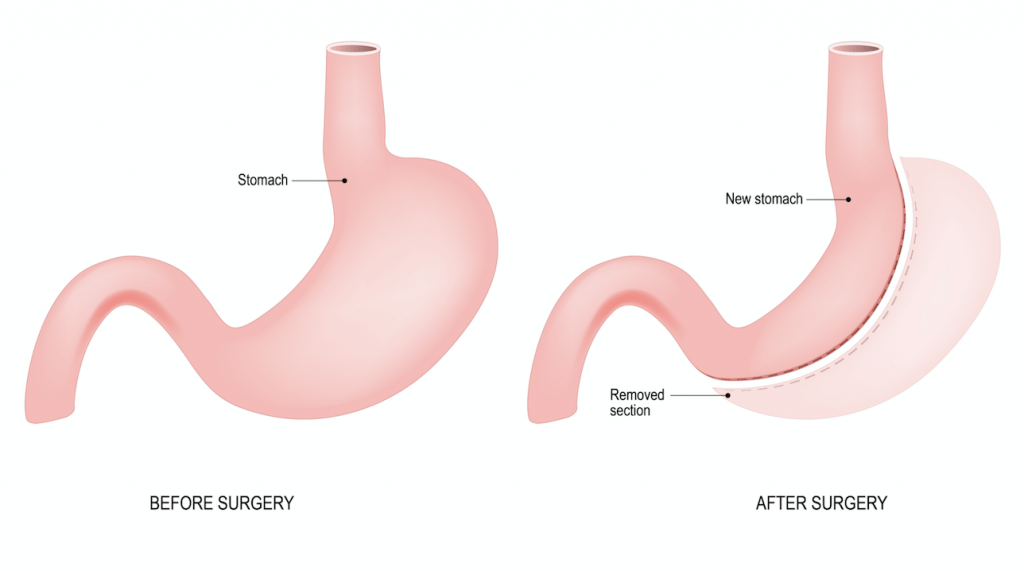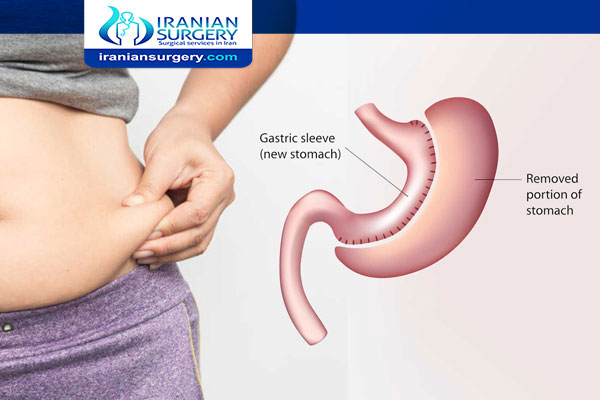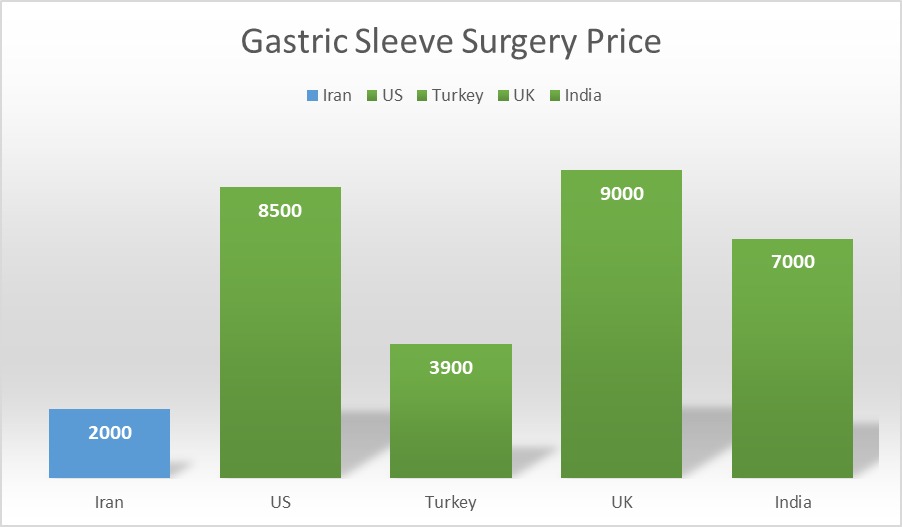How much does Gastric Sleeve surgery cost in Iran?
Cost of gastric sleeve at Tehran city in 2022 starts from 2800 USD. However if you want a cheaper price with the same quality you can choose Shiraz city where gastric sleeve cost starts from 2000 USD.
Gastric Sleeve Surgery
Gastric Sleeve surgery is one of the latest methods for weight loss which is quite effective and safe. This highly advanced procedure is a non-invasive method that reduces the volume of the stomach and limits the amount of food and in turn helps you lose the extra weight. This type of surgery aims to change the shape of the stomach and abdomen and leads to a smaller stomach. This surgery can lead to a 50% weight loss.
This method is less invasive than other methods and therefore significantly reduces the risk of any complications. Another advantage of this approach is a quick return to daily activities.
Read more about : Gastric sleeve recovery time
Read more about : Skin rash after gastric sleeve
General information about Gastric Sleeve Surgery
General Information |
|
Cost | $ 2000- 3300 |
Anesthesia | General |
Hospital Stay | 2 to 3 Days |
Back to Work | 1 to 2 Weeks |
Duration of Operation | 1 to 2 Hours |
Minimum Stay in Iran | 7-10 Days |
Gastric Sleeve or Stomach Reduction
These days, many applicants who entertain the idea of losing weight and getting in shape use the gastric sleeve method, and many of them are concerned about finding the best doctor and the most suitable country to undergo this operation. Iran has been able to provide the best doctors and surgeons along with highest quality of medical services and consolidate its place as a perfect destination for those looking to shed unwanted pounds without working up a sweat.
The low cost of medical services, fascinating tourist attractions and the low cost of accommodation are among the things that can have a significant impact on the choice of clients to travel to Iran. The Iranian Surgery team is always trying to provide the most experienced medical team with the highest quality of medical services at most reasonable prices possible, in order to create the best conditions for all applicants.
The Iranian Surgery support team is always ready to answer your questions. All you have to do is send us an email or contact us on WhatsApp number +98 901 929 0946.

Read more about : What is the difference between gastric sleeve and duodenal switch?
Read more about : Gastric bypass vs duodenal switch

Before Gastric Sleeve Surgery
Why it's done
Sleeve gastrectomy is done to help you lose excess weight and reduce your risk of potentially life-threatening weight-related health problems, including:
. Heart disease
. High blood pressure
. High cholesterol
. Obstructive sleep apnea
. Type 2 diabetes
. Stroke
. Cancer
. Infertility
Sleeve gastrectomy is typically done only after you've tried to lose weight by improving your diet and exercise habits.
In general, sleeve gastrectomy surgery could be an option for you if:
. Your body mass index (BMI) is 40 or higher (extreme obesity).
. Your BMI is 35 to 39.9 (obesity), and you have a serious weight-related health problem, such as type 2 diabetes, high blood pressure or severe sleep apnea. In some cases, you may qualify for certain types of weight-loss surgery if your BMI is 30 to 34 and you have serious weight-related health problems.
You must also be willing to make permanent changes to lead a healthier lifestyle. You may be required to participate in long-term follow-up plans that include monitoring your nutrition, your lifestyle and behavior, and your medical conditions.
Is a gastric sleeve right for me?
The minimum requirements to qualify for gastric sleeve surgery include:
. A body mass index (BMI) of 40 or more, OR
. You have a BMI of 35 or more and you have other medical conditions such as type 2 diabetes or high blood pressure that may be improved by losing weight.
Patients who qualify for gastric sleeve surgery usually:
. Are at least 80 lbs (36 kg) overweight.
. Are between 18 and 75 years old
. Have a history of failed weight loss attempts (example: failed diets)
. Thoroughly understand that the procedure is just a tool; your long-term success requires you to make significant diet and lifestyle changes.
Complications and Risks
There are two types of complications of gastric sleeve surgery: acute and chronic. Acute complications are ones that occur shortly after surgery and chronic issues are ones that arise or persist six months after the date of surgery. Acute complications include bleeding, pain, and blood clots.
Gastric sleeve, overall, is considered safe when compared to other commonly performed surgeries. Deaths from the procedure are rare, and when performed by a competent surgeon, the procedure has minimal complications. That said, complications, when they do happen, can range from minor annoyances to significant and potentially life-altering issues.
Over the past decade, with the improvement of surgical techniques and surgeons’ experience, the gastric sleeve has become an overall safe bariatric surgical procedure. However, complications can still occur during and after surgery.
Below are the main complications and risks of the gastric sleeve surgery:
. Leakage from the staple line – this is a rate but serious complication of the gastric sleeve surgery. The reported leak rate is between 0.7-3 percent. In Iran, we pay paramount attention to our surgical techniques to minimize all the complications.
. Stricture/stenosis - In the past, we had one stricture among our first 20 gastric sleeve procedures. We have not had any strictures within the past 5 years.
. Bleeding
. Blood Clot
. Heart Burn – This is a very controversial topic in bariatric surgery and the data from different centers is inconsistent. In our experience, most patients with heartburn before surgery see improvement of symptoms after surgery due to weight loss. Some patients may develop new heartburn, which is treatable with over-the-counter anti-acid medications, in most cases.
Read more about : Gastric Band vs Gastric Sleeve
Read more about : Mini gastric bypass VS gastric bypass
. Nutrient or vitamin deficiency
. Weight Regain
After two years, about 1 out of every 20 gastric sleeve patients have gained back some weight from their low point.
At 5 years, the average gastric sleeve patient regains as much as 50% of the weight they lost. Just as bad, the more weight you gain back, the more likely your health problems are to return.
The reasons for weight regain?
. Consuming calories in liquid form, such as protein shakes, pureed foods, smoothies, etc. Your new sleeve stomach works by making you feel full sooner when you eat. Since liquids don’t make you feel as full as solid foods, you’ll eat more and gain weight if you get your calories from liquids instead of solids.
. Overeating or eating the wrong things. This can stretch out the smaller gastric sleeve stomachs over time which will allow you to eat more and gain unwanted weight.
Remember, gastric sleeve is one of the best tools for weight loss, but it is only a tool. To avoid weight regain, you’ll need to eat the right foods and make the right lifestyle choices.
. Sagging Skin
For most obese patients, the skin has been stretched out for so long to accommodate the extra weight that it has lost its elasticity. Gastric sleeve surgery causes most patients to lose a lot of weight very quickly, and your skin simply can’t keep up.
The extra skin may be embarrassing. It can also cause several issues ranging from minor to severe, including:
. Hard time getting dressed
. Uncomfortable to exercise
. Skin problems, such as rashes and infections
In some cases, patients manage sagging skin with body-contouring undergarments. In more serious cases, patients have plastic surgery to remove the excess skin.
. Digestive Issues
About 1 in every 5 patients experience Gastroesophageal reflux disease (GERD) in the first 12 months. The good news is that this tends to be a shorter-term issue. After 3 years, the GERD rate drops to around 3% of patients.
Other potential digestive issues resulting from gastric sleeve surgery include:
. Indigestion (Dyspepsia)
. Gallstones
. Developing an intolerance to some food types
. Vomiting or nausea
. Vitamin deficiency
These digestive issues can often be addressed and fixed with diet and behavior changes.

What are some advantages and disadvantages of the Gastric Sleeve surgery?
Pros:
. Can lead to significant weight loss (average of 66% of excess body weight)
. Can lead to significant improvement of obesity-related health conditions
. Doesn’t use a foreign object (like the gastric band) and doesn’t reroute the digestive tract (like the gastric bypass)
. Short hospital stays approximately 2 days and recovery time due to minimally invasive procedure
. Limits the amount of food that can be eaten
. Causes significant changes to digestive organs and hormones that result in reduced hunger and increased metabolism.
. Permanent (won’t need more surgeries or readjustments, like the gastric band)
Cons:
. Requires lifelong dedication to specific diet and exercise routines
. Permanent (cannot be reversed)
. Can lead to vitamin deficiencies
How do I get ready for gastric sleeve surgery?
Your healthcare team will need to make sure that gastric sleeve surgery is a good option for you. Weight-loss surgery isn’t advised for people who abuse medicines or alcohol, or who are not able to commit to a lifelong change in diet and exercise habits.
Before having surgery, you’ll need to enroll in a bariatric surgery education program. This will help you get ready for surgery, and life after surgery. You’ll have nutritional counseling. And you may have a psychological evaluation. You’ll also need physical exams and tests. You will need blood tests. You may have imaging studies of your stomach, or have an upper endoscopy.
If you smoke, you will need to stop several months before surgery. Your surgeon may ask you to lose some weight before surgery. This will help make your liver smaller, and make surgery safer. You’ll need to stop taking aspirin, ibuprofen, and other blood-thinning medicines in the days before your surgery. You shouldn’t eat or drink anything after midnight before surgery.
During Gastric Sleeve Surgery
The Procedure
This procedure works by several mechanisms. First, the new stomach pouch holds a considerably smaller volume than the normal stomach and helps to significantly reduce the amount of food (and thus calories) that can be consumed. The greater impact, however, seems to be the effect the surgery has on gut hormones that impact a number of factors including hunger, satiety, and blood sugar control.
The procedure can take between one and two hours, but this may vary between surgeons.
Read more about : Mini gastric bypass surgery side effects
Read more about : Mini gastric bypass surgery pros and cons
How is Gastric Sleeve Performed?
Most sleeve gastrectomies performed today are performed laparoscopically. This involves making five or six small incisions in the abdomen and performing the procedure using a video camera (laparoscope) and long instruments that are placed through these small incisions.
Sleeve gastrectomy is a restrictive form of operation in which approximately 2/3rd of the left side of the stomach is removed laparoscopically using endoscopic staplers. The stomach thus takes the shape of a hockey stick or sleeve.
The capacity of the stomach ranges between 60 - 100 cc. Unlike many other forms of bariatric surgery, the outlet valve and the nerves of the stomach remains intact while only the stomach size is drastically reduced. Though a non-reversible procedure, the part of the stomach that contains Ghrelin, the hormone for hunger is removed; it drastically reduces your appetite and hormones that controls diabetes.
The hour glass configuration only constricts the upper stomach thus acting as a pure restrictive operation. Since the outlet is small, food stays in the pouch longer and one also feels satiated for a longer time.
Why Gastric Sleeve works
. Reduced stomach size makes the patient feel full sooner after eating
. Removed portion of the stomach means fewer hunger-causing hormones are secreted, causing patient to feel less hungry generally.
After gastric sleeve surgery
What happens after gastric sleeve surgery?
You’ll likely go home the day after surgery. You will be on a liquid diet for the first week or two. Your surgery team will give you a schedule of types of meals over the next weeks. You’ll go from liquids to pureed foods, then soft foods, and then to regular food. Each meal needs to be very small. You should make sure to eat slowly and chew each bite well. Don’t move too quickly to regular food. This can cause pain and vomiting. Work with your healthcare team to figure out what’s best for you to eat. After your stomach heals, you will need to change your eating habits. You’ll need to eat small meals for your small stomach.
People who have weight-loss surgery may have trouble getting enough vitamins and minerals. This is because they take in less food, and may absorb fewer nutrients. You may need to take a daily multivitamin, plus a calcium-vitamin D supplement. You may need additional nutrients, such as vitamin B-12 or iron. Your medical team will give you instructions.
You’ll need to have regular blood tests every few months in the year after surgery. This is to make sure you don’t have low blood iron (anemia), high blood glucose, or low calcium or vitamin D levels. If you have heartburn, you may need to medicine to reduce stomach acid.
After losing weight, it’s possible to regain some of the weight that you lose. To avoid this, make sure to follow a healthy diet and get regular exercise. The sleeve may widen (dilate) over time. This will let you eat more. But keep in mind that if you eat all you can, you can regain weight. You may want to join a weight-loss surgery support group to help you stick with your new eating habits.
Recovery
What is the Recovery Time for Gastric Sleeve Surgery?
If you are curious to know what the Recovery Time is for Gastric Sleeve Surgery, read the following gastric sleeve recovery guide to learn what you can expect after your sleeve gastrectomy.
Surgery Day
After your gastric sleeve surgery, you will wake up in the hospital, a bit tired, and without a lot of pain. You may feel happy. The happy feeling is usually due to the excellent pain medication your doctor has already administered, but it’s also due, in part, to the sense of relief that comes from knowing that you’re done and safe.
. Pain
Pain is typically moderate on the first day. You still have your IV in your arm, and it’s easy to administer pain medication as needed. Be sure to communicate to your nurse or your surgeon what you need. Individuals respond to pain differently.
You will have 5 or 6 small incisions on your abdomen which will be sutured and covered to heal. The incision that typically causes the most pain is the site that the surgeon removed a large portion of your stomach. The incision is often located in the lower left quadrant of your abdomen. It could also be on the right side. Look for the largest incision.
At this point, you will be laying in a hospital bed so you may feel a general sense of soreness across your abdomen. You may experience residual nausea from the anesthesia, but this should improve quickly.
. Diet
Nothing by mouth at this point. Some surgeons allow their patients to have mouth swabs. Others allow a cup of ice every few hours. You’ll probably feel dehydrated and want to drink something, but you likely won’t be able to do this until the following day.
Your throat is going to be sore and swollen from the ET tube (breathing tube during surgery), so it’s not pleasant to eat or drink at this point anyway. You will be exhausted, and while you might worry that you’ll be hungry, it is likely that you will not be hungry. Part of your stomach has been removed, and your hunger-causing hormone (ghrelin) levels are likely low.
. Activity
Your surgeon may want you up and walking. Walking helps reduce the pain that can result from the CO2 used during laparoscopic surgery. When you aren’t walking, you’ll mostly be on your back with a slight incline on the hospital bed.
Getting out of bed the first day is difficult. It’s almost like exercising a sore muscle. It will hurt. The more you are out of bed and walking, the better you will feel the following day.
Day 1 after Surgery
You’ve probably had a somewhat restless night that included a lot of channel surfing while dozing in and out of sleep. Today, your radiologist will administer a swallow test to make sure there are no leaks before your surgeon will allow you to drink water.
. Pain
Pain is typically more noticeable at this point. The anesthesia has worn off, and while your pain medications are working, you’re also moving a bit more. When you turn your trunk, pain is evident. Assuming your case was laparoscopic, your pain should be bearable. Different positions will offer different levels of comfort. Your throat is sore, swollen and dry; another source of pain but the small sips of water help.
You will be expected to use the IV pain medicine less and use oral medications more. The IV pain medicine works faster than the oral medicine, so do not wait until the pain is unbearable to ask for the nurse to give you something by mouth.
. Diet
You can drink clear liquids. Go easy but enjoy it. At this point, you may or may not be hungry. Many people are still not hungry at this point. But almost everyone is dehydrated and thirsty.
Follow the diet that your surgeon recommends. Most surgeons will allow for the following foods at this point.
. Broth
. Unsweetened juice
. Milk
. Strained cream soup
. Sugar-free gelatin
Drink only small amounts of food at this point. Do not drink any carbonated beverages and nothing with caffeine. Caffeine has a slight diuretic effect. One of the common reasons for readmission after bariatric surgery is dehydration.
. Activity
You may be carted around for your swallow test in Radiology (which is usually in the basement of most hospitals). After your swallow test, your doctor should meet with you again. At this point, he’ll probably check your pain, remove your catheter, make sure you can get up and on your feet and answer any questions you might have. A few hours later, your surgeon should discharge you with care instructions for your wounds and prescriptions for pain medication. Make sure you get these filled. Head home and read over your post-operative instructions.
Read more about : How to tone up after gastric bypass?
Day 2 to 2 Weeks after Surgery
You are most likely on your own at this point. Your surgeon has discharged you from the hospital. That team of people that you had to help is now gone. Your spouse, family, or friend that has taken good care of you may be back at work. You have to do the heavy lifting. And, you may miss the pain pump or the IV administered pain medications that seemed to work better at the hospital.
. Pain
Pain is still bearable for most people. Patients often experience the most pain between days 3 and day 6. Pain during days 3 to 6 is common because you are up on your feet more, turning your trunk more, and generally more active than before.
Typically, people report pain in the range of 5/10 with some people’s pain getting up to a 7/10. Your doctor should have given you instructions regarding pain at this point as well. If the pain is unbearable or not what your surgeon told you to expect, you should let your surgeon know.
Most of your pain is restricted to the port sites (little incisions on your belly covered with a small dressing or glue). The biggest port usually causes most of your pain. The biggest port is the incision where the surgeon removed the resected portion of your stomach. This incision is often stretched to get the stomach out, and that stretching can result in more pain and bruising at this location.
Pain should slowly improve each day. Pain that is associated with vomiting, fever, new pains in the shoulder or back, and pains that don’t respond to oral pain medicine, are all reasons to call your surgeon.
. Diet
Always continue to follow the diet your surgeon has given you. That diet will likely progress from clear liquids to full liquids for the next week.
. Water
. Fat-free milk
. Sugar-free juice
. Broth
. Protein shakes (check with your diet guidelines)
. Sugar-free Jell-O
. Carnation instant breakfast. Look for the sugar-free option (check with your diet guidelines)
. Very thin creamed soups. No chunks.
Remember to stay hydrated. Your body is used to getting a lot of fluids from food, which it will no longer be getting. Stay hydrated and if you have diabetes and be sure to check your sugar levels regularly. Your diabetic medications have likely been reduced as part of your discharge plan. Right now, a sugar of 150 is much better than one of 55.
. Activity
At this point, you will probably start to feel exhausted. Your diet is limited, and your body is not used to the limited number of calories. You’ve also just been through major surgery. A lot of your body’s energy is focused on recovery.
As always follow your doctor’s guidelines. As it pertains to activity, this mostly includes rest. Some doctors will want you walking a few times a day around the house. Keep your activity limited. You won’t have the energy for much more.
Climbing stairs is acceptable but step every few seconds. Don’t carry anything up or down the stairs with you. Driving is not permitted while taking narcotic pain medication. Lifting is permitted, as long as it is something you can comfortably lift with one arm.
Week 2 & 3 after Surgery
Some people are ready to get back to work after week 1. Most people are still in too much pain when they twist and turn to think about work. And, surprisingly, many people say they are just too tired to work. Their bodies are still adjusting to the new food regimen.
. Pain
Pain should not be severe. It should be tolerable but probably nagging. It will be most noticeable when you start to do errands, like getting in and out of your car.
. Diet
You will likely eat these soft pureed foods for two to four weeks. This diet includes foods that have the consistency of a smooth paste or thick liquid. There should be no solid pieces of food in the mixture.
Foods that blend well are recommended. These include:
. Soft vegetables – steam or boil them until they are soft.
. Soft cheeses – limit these, they are typically high in fat.
. Ground chicken or beef. Add some beef or chicken stock to keep the meat soft.
. Soups
. Scrambled eggs – these are a great source of protein
. Beans
. Fish
. Yogurt
. Cottage cheese
And it helps to blend the solid food with liquids:
. Water
. Fat-free milk
. Juice
. Broth
Over the next 2 to 4 weeks you’ll probably hate your blender and crave more substantial meals. But your diet hasn’t changed from the pureed foods. It’s essential to stick to the diet that your surgeon prescribes – this can be tough but necessary. Eating solids such as nuts or fibrous vegetables could cause your staple line to rupture, and you could leak. A leak is life-threatening. The good news is that you’ve already lost weight. And this should encourage you to stick to your new diet.
It’s still very easy to become dehydrated, so drink your fluids.
. Activity
Follow the exercise/activity regimen your surgeon has provided. The exercise regimen is not more than simple daily walks. In most instances, patients are encouraged to walk 3 to 5 times per day for 5 to 10 minutes at a time, gradually increasing the length of each walk as tolerated. Other forms of exercise are generally not recommended. Weight training is contraindicated at this point.
If returning to the gym is permitted by your surgeon, cut everything in half; half the time at the gym, half the speed/time on the treadmill, half the weights lifted and reps performed. Gradually work back to where you were pre-operatively.
Read more about : Bariatric surgery requirements
Read more about : Ideal BMI for liposuction
Read more about : Ideal BMI for tummy tuck
Week 3 to Month 3
You’re back at work, and you’ve already lost a fair amount of weight. While some people still feel a bit tired, most people are encouraged by their weight loss, feel lighter, and some have more energy than they did before surgery. You may need additional support during this stage. Your mood is likely to be up and down.
. Pain
By month 2, you shouldn’t have much pain, and you are probably off of all pain medications. If you’re still experiencing pain, make sure your doctor is aware of it.
. Diet
After a few weeks of soft, pureed foods it is time for a change. With your doctor’s approval, you can add soft, solid foods to your diet. These include:
. Ground or finely diced meats
. Canned or soft, fresh fruit
. Cooked vegetables
This diet usually lasts about eight weeks or so before your doctor will clear you to eat solid foods. This diet is a significant improvement over the soft, pureed foods only diet. Remember, you’re losing weight – stick to the diet. Aside from losing weight, you do not want to risk any complications.
This diet usually lasts about eight weeks or so before your doctor will clear you to eat solid foods. This diet is a significant improvement over the soft, pureed foods only diet. Remember, you’re losing weight – stick to the diet. Aside from losing weight, you do not want to risk any complications.
. Activity
Depending on your fitness level, your bariatric surgeon may approve increased activity (more than just walking) after 30 days. Activities may include swimming and low-impact aerobic exercise. For many patients, water aerobics can be an excellent option. It is easy on the back, hips, knees, and ankles, and is excellent cardiovascular exercise. It is worthwhile to investigate gym memberships at facilities that have a pool. Regardless of the type of activity that your doctor recommends, he will still likely ask you to stay at a low aerobic level where speaking is always comfortable.
Month 3 to 6 And Beyond
At this point, you should be happy you decided to have gastric sleeve surgery. You’ve started to lose a very visible amount of weight. You’re lighter on your feet, and your surgeon has probably approved you for solid foods.
. Pain
There should not be much if any, pain at this point. If you still have pain, discuss this with your doctor.
. Diet
After about two months, your doctor will probably approve of solid foods. While this is very exciting, start slowly. You may find that spicy and crunchy foods can be challenging to tolerate. Eat one new food at a time and give yourself time to digest. You’ll be surprised at how full you will feel. Now is an opportunity to start new eating habits. Eat slowly. Enjoy every bite of your food. Some of them offer great recipes for bariatric surgery patients. You should have a dietitian for regular follow-up appointments.
. Activity
Talk to your doctor about starting a more rigorous exercise routine. You’ll probably want to get into the gym or start a regular exercise routine. The gym is good, but make sure your surgeon is aware of your routine. Most surgeons suggest waiting until about six months before adding weights into your exercise routine. Increase your aerobic exercise. You’ll probably want to take longer walks, and even jogs! Do not stop exercising. Exercise is an important aspect of your new life. Every day is a new day. Whether or not you exercised yesterday or the day before, today you can make yourself a little healthier and happier.
Recommended eating behaviors after Gastric Sleeve Surgery
Following gastric sleeve surgery, it is important for a person to change not only the food that they eat but also how they eat it.
People will need to alter their eating behaviors to reduce the risk of postsurgical complications. Recommended adjustments include:
. Consuming between four and six smaller meals every day instead of three large ones
. Chewing thoroughly and slowly
. Ending a meal upon feeling full
. Choosing balanced meals with high protein content
. Avoiding eating due to stress or boredom, as this may reduce the long-term, positive effect of the procedure
. Taking dietary supplements, possibly on a lifelong basis due to the reduced intake of certain nutrients, including protein
. Drinking at least 1.5 liters of fluid every day
. Avoiding drinking fluids within 15–30 minutes of a meal, as this may lead to vomiting.
Foods to avoid
Some foods increase a person’s risk of experiencing problems after gastric sleeve surgery and other bariatric procedures. Therefore, people should exclude certain types of food and drink from their diet to reduce the chances of an adverse event.
These foods and drinks include:
. Hard and dry foods, which a person might find difficult to swallow following surgery.
. Calorie dense foods and beverages, such as ice cream, cakes, chocolate, and milkshake
. Carbonated and sugar sweetened drinks, such as soda
. Foods with a high glycemic index, such as bread, rice, and potatoes, which can cause a rapid increase in blood sugar levels.
. Chewing gum and foods that contribute to flatulence, such as beans.
Results
Sleeve gastrectomy can provide long-term weight loss. The amount of weight you lose depends on your change in lifestyle habits. It is possible to lose approximately 60%, or even more, of your excess weight within two years.
In addition to weight loss, sleeve gastrectomy may improve or resolve conditions related to being overweight, including:
. Heart disease
. High blood pressure
. High cholesterol
. Obstructive sleep apnea
. Type 2 diabetes
. Stroke
. Infertility
Sleeve gastrectomy surgery can also improve your ability to perform routine daily activities, and can help improve your quality of life.
When weight-loss surgery doesn't work
It's possible to not lose enough weight or to regain weight after weight-loss surgery. This weight gain can happen if you don't follow the recommended lifestyle changes. If you frequently snack on high-calorie foods, for instance, you may have inadequate weight loss. To help avoid regaining weight, you must make permanent healthy changes in your diet and get regular physical activity and exercise.
It's important to keep all of your scheduled follow-up appointments after weight-loss surgery so that your doctor can monitor your progress. If you notice that you aren't losing weight or you develop complications after your surgery, see your doctor immediately.
Gastric Sleeve Surgeons
Read more about : Virgin tightening surgery before and after
Read more about : Lipomatic
Read more about : Plastic surgery in Iran
Read more about : Liposuction in Iran
The factors that the best Bariatric surgeons should have:
- Experience
Because of performing a great number of procedures, they become knowledgeable and highly skilled which make them very famous worldwide.
- Expertise in different types of Bariatric surgery
It is of paramount importance that your surgeon be expert in various types of Bariatric surgery.
We are happy to introduce a great number of Iranian surgeons who have all two above-mentioned features.
How much does Gastric Sleeve surgery cost?
On average, the cost of Gastric Sleeve surgery in Iran is between $2000-3300.
Factors such as the surgeon’s location, credentials, and the type of facility where the procedure is being performed all impact the final cost.

How can I find the best Gastric Sleeve surgeon in Iran?
Iranian Surgery is an online medical tourism platform that helps you to do Gastric Sleeve Surgery with the best Bariatric Surgeons in Iran at the most affordable price.
For more information and to schedule an appointment, contact our consultants via WhatsApp number +98 901 929 0946.
This service is completely free




6 Comments
How much of the stomach is removed in gastric sleeve?
During the sleeve gastrectomy in iran, about 75 percent of the stomach is removed leaving a narrowgastric tube or “sleeve” (pictured right). No intestines are removed or bypassed during the sleeve gastrectomy. Gastric Sleeve In Iran takes one to two hours to complete
Hi,
I would like to have gastric sleeve surgery in February. How much will it cost the whole package please?
Kind regards
Naomi
Hello dear Naomi, would you please send me a messsage on WhatsApp to provide you with enough information. This is my whatsApp number +989019290946
thank you.
I would like the gastric sleeve are flights included in the price and pick up from the airport to hospital transfer there and back as il be flying alone so want to feel safe and want to come asap 0794609691
Due to numerous clients from different corners of the world, we can not include flights in the packages. however the complete transfer service is included (airport transfer and all transfers between the hotel and the hospital). We assure our clients to be assisted through the whole process, so they don’t have to be worried about traveling alone. Here, Iranian surgery team will be your family.